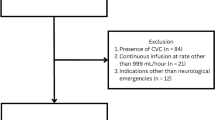Abstract
Objective
To compare the efficacy of phenobarbitone and phenytoin for treatment of neonatal seizures in term and nearterm neonates.
Design
Open labeled randomized controlled trial.
Setting
Neonatal intensive care unit of a level II unit from India, from November 2008 to September 2009.
Participants
All term and late pre-term neonates admitted with clinically apparent seizures and not having any transient metabolic disorders (hypoglycemia or hypocalcemia) were randomly assigned.
Intervention
Phenobarbitone (n=54) or phenytoin (n=55) intravenously 20 mg/kg/dose over 20–30 min. Neonates whose seizures were not controlled by the assigned drug were then crossed over to be treated with other drug in same dose.
Primary outcome variable
Clinical control of seizures (seizure free period of 24 hours after giving anticonvulsant).
Results
Baseline characteristics including mean birthweight, gestation age and sex were comparable in both groups. Seizures were controlled in 8 of the 55 (14.5%) neonates who received phenytoin, as compared to 39 of 54 (72.2%) neonates who received phenobarbitone (P <0.001). In babies not responding to assigned drugs, after cross-over to the other drug, seizure control was achieved in 44/55 (80%) of the neonates assigned to receive phenytoin first as compared to 49/54 (91%) of those assigned to receive phenobarbitone first (P=0.014). After maximum dose of phenobarbitone seizures were controlled in 49/55(89%) in phenytoin group and 52/54 (96%) in phenobarbitone group (P<0.05).
Conclusion
Phenobarbitone is more efficacious than phenytoin in control of clinical seizures in term or near-term neonates, irrespective of etiology.
Similar content being viewed by others
References
Vanrman C, Darrvish H. Efficacy of phenobarbital in neonatal seizures. Can J Neurol Sci. 1985;12:95–99.
Lockman LA, Kriel R, Zaske D, Thompson T, Virnig N. Phenobarbital dosage for control of neonatal seizures. Neurology. 1979;29:1445–1449.
Boylan GB, Rennie JM, Pressler RM, Wilson G, Morton M, Binnie CD. Phenobarbitone, neonatal seizures, and video-EEG. Arch Dis Child Fetal Neonatal Ed. 2002;86:165–167.
Painter MJ, Scher MS, Stein MD, Armatti S, Gardner JC. Phenobarbitone compared with Phenytoin for neonatal seizures. N Engl J Med. 1999;341:485–489.
Volpe JJ. Neonatal Seizures. In: Neurology of the Newborn. Philadelphia: WB Saunders; 1999. P.172–225.
Massingale TW, Buttross S. Survey of treatment practices for neonatal seizures. J Perinatol. 1993;13:107–110.
Jeeva Sankar M, Agarwal R, Aggrawal R, Deorari AK, Paul VK. Seizures in the newborn. Indian J Pediatr. 2008;75:149–155.
Gilman JT, Gal P, Duchowny MS, Weaver RL, Weaver RL, Ransom JL. Rapid sequential phenobarbitone treatment of neonatal seizures. Pediatrics. 1989; 83:674–678.
Mizrahi EM, Kellaway P. Characterization and classification of neonatal seizures. Neurology. 1987; 37:1837–1844.
Murray DM, Boylan GB, Ali I, Ryan CA, Murphy BP, Connolly S. Defining the gap between electrographic seizure burden, clinical expression and staff recognition of neonatal seizures, Arch Dis Child Fetal Neonatal Ed. 2008; 93: F187–F191.
McCown TJ, Breese GR. The development profile of seizure genesis in the inferior collicular cortex of the rat: Relevance to human neonatal seizures. Epilepsia. 1992;33:2–10.
Ranck JB, Windle WF. Brain damage in monkey, Macaca Mulatta, by asphyxia neonatorum. Exp Neurol. 1959;1:130.
Faro MD, Windle WF. Transneuronal degeneration in brains of monkeys asphyxiated at birth. Exp Neurology. 1969; 24: 38–53.
Dað Y, Fýrat AK, Karakå HM, Alkan A, Yakýncý C, Erdem G. Clinical outcomes of neonatal hypoxic ischemic encephalopathy evaluated with diffusion-weighted magnetic resonance imaging. Diagn Interv Radiol. 2006;12:109–114.
Robertson C, Finer N. Term infants with hypoxic-ischemic encephalopathy outcome at 3.5 years. Dev Med Child Neurol. 1985;27: 473–484.
Holt DE, Halket S, de Louvois J, Harvey D. Neonatal meningitis in England and Wales, 10 years on. Arch Dis Child Fetal Neonatal Ed. 2001;84: F85–9.
Stevens JP, Eames M, Kent A, Halket S, Holt D, Harvey D. Long term outcome of neonatal meningitis. Arch Dis Child. 2003;88:179–184.
Klinger G, Chin CN, Beyenne J, Perlman M. Predicting the outcome of neonatal bacterial meningitis. Pediatrics. 2000; 106: 477–482.
Author information
Authors and Affiliations
Corresponding author
Rights and permissions
About this article
Cite this article
Pathak, G., Upadhyay, A., Pathak, U. et al. Phenobarbitone versus phenytoin for treatment of neonatal seizures: An open-label randomized controlled trial . Indian Pediatr 50, 753–757 (2013). https://doi.org/10.1007/s13312-013-0218-6
Received:
Revised:
Accepted:
Published:
Issue Date:
DOI: https://doi.org/10.1007/s13312-013-0218-6




